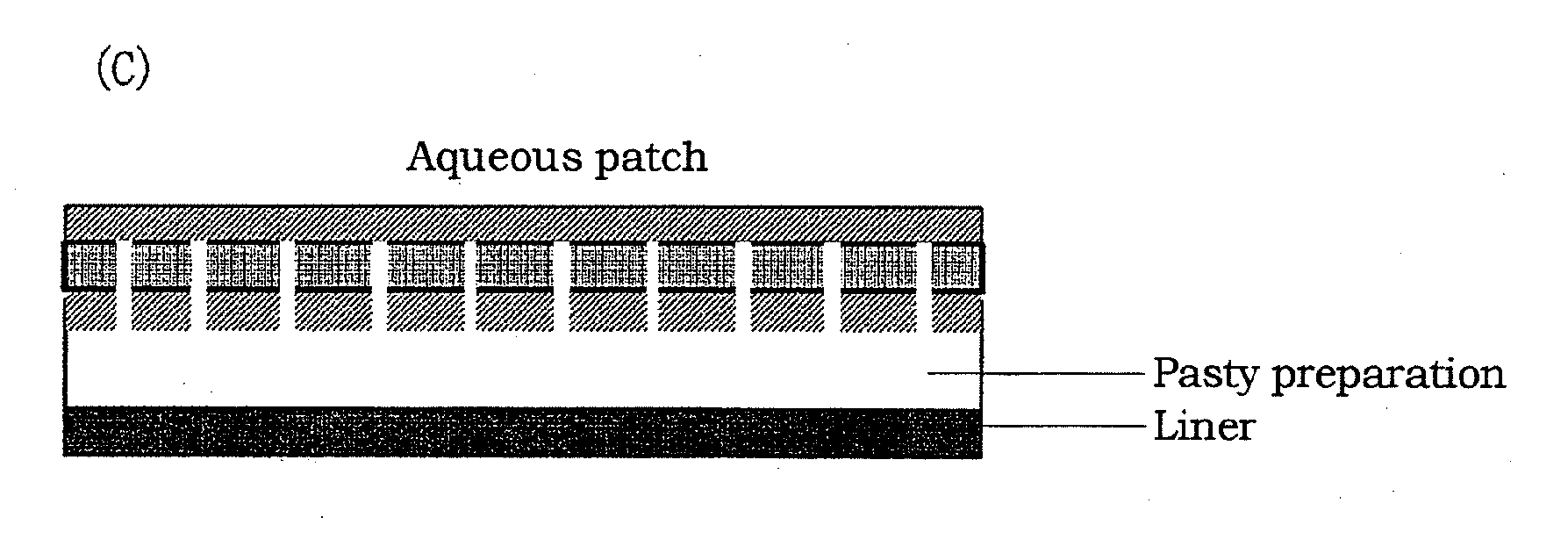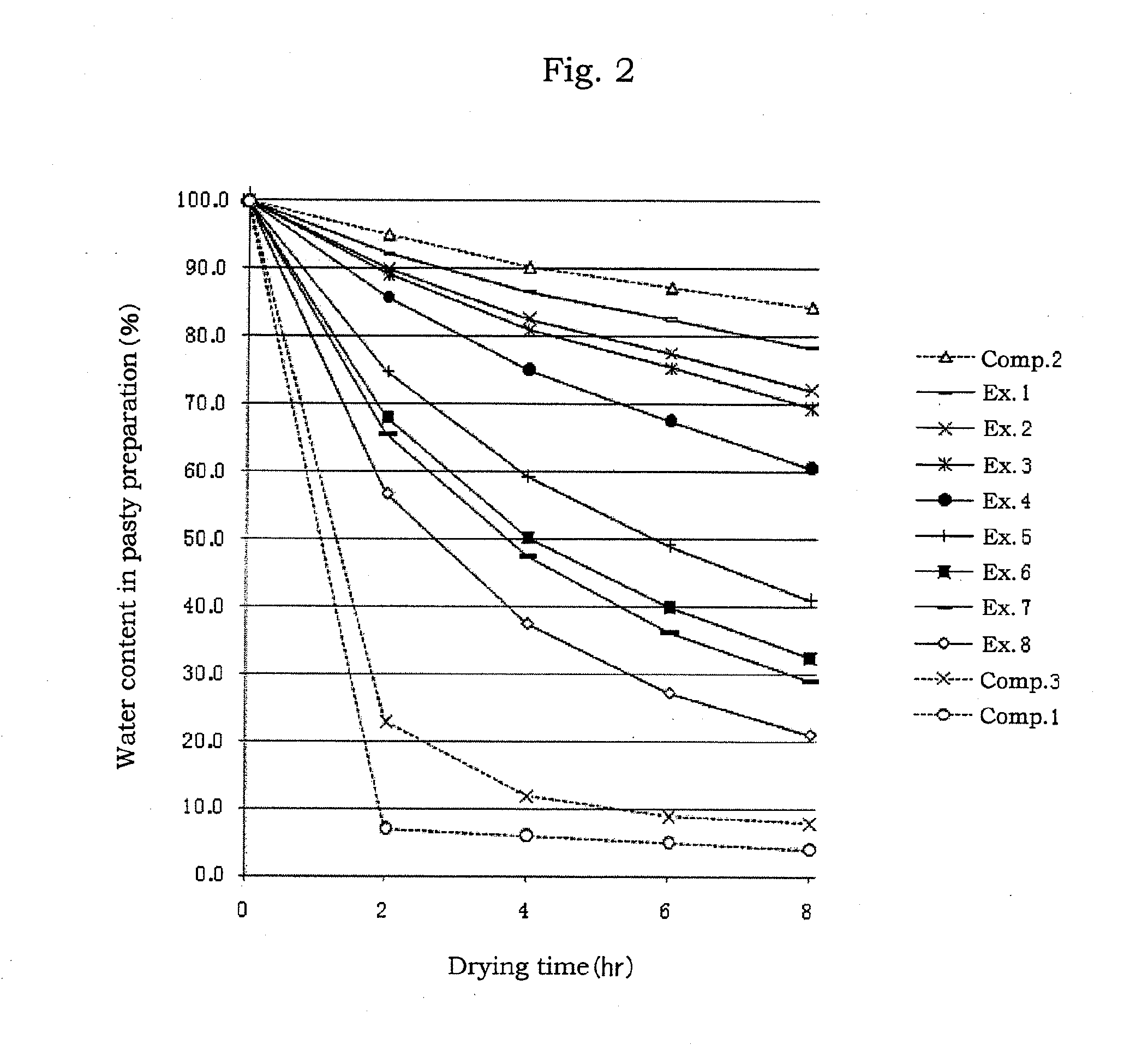Backing having three-layer structure and aqueous patch using the backing
a technology of aqueous patch and three-layer structure, which is applied in the direction of dressings, bands, transportation and packaging, etc., can solve the problems of difficulty in controlling the water evaporation of an aqueous patch, the inability to apply aqueous patches for a long time, and the decrease of the water content in the pasty preparation
- Summary
- Abstract
- Description
- Claims
- Application Information
AI Technical Summary
Benefits of technology
Problems solved by technology
Method used
Image
Examples
examples
[0066]Although the present invention will be explained with Examples below, the present invention is not intended to be limited to these Examples by any means.
Example (Ex.) 1
[0067]To 30 g / m2 of polyethylene nonwoven fabric as the fiber layer was heat-sealed 15 μm of polyethylene film (ethylene-1-octene copolymer), and perforated by a hot needle. Furthermore, 30 g / m2 of polyethylene nonwoven fabric as the outer fiber layer was partially stuck by an adhesive agent on the film surface opposite to the inner fiber layer to obtain a backing having a three-layer structure with 16 holes / cm2, the hole area of 0.13 mm2 / hole, and the opening area of 2.5 mm2 / cm2.
[0068]The moisture permeability of this backing was measured according to the method described in the Japanese Industrial Standards (Jis) L1099. The moisture permeability of this backing was 994 g / m2·24 h.
[0069]Then, to 400.2 g of glycerin were added 40 g of partially neutralized polyacrylic acid, 40 g of carboxymethylcellulose sodiu...
examples 2-8
[0071]The backing having the three-layer structure, in which the hole area and the opening area were adjusted by a perforating process using a hot needle, was prepared, and the moisture permeability of each backing was measured.
[0072]The hole area, the opening area, and the measured moisture permeability of each backing are shown in Table 1.
[0073]Furthermore, using each backing, the pasty preparation prepared in the same way as Example 1 was spread on the backing to prepare the aqueous patch of each Example. Each obtained patch was sealed in a packaging bag, and stored at room temperature.
example 9
[0090]To 30 g / m2 of polyethylene nonwoven fabric as the inner fiber layer was heat-sealed 20 μm of polyethylene film (ethylene-1-octene copolymer), and perforated by a hot needle. Furthermore, 50 g / m2 of polyethylene nonwoven fabric as the outer fiber layer was partially stuck by an adhesive agent on the film surface opposite to the inner fiber layer to obtain a backing having a three-layer structure with 32 holes / cm2, the average hole area of 0.099 mm2 / hole, and the opening area of 3.7 mm2 / cm2. The moisture permeability of this backing was 3700 g / m2·24 h.
[0091]Then, a pasty preparation was prepared. To 390 g of glycerin were added 40 g of partially neutralized polyacrylic acid, 40 g of carboxymethylcellulose sodium, 2.5 g of hydroxypropylcellulose and 0.7 g of dihydroxyaluminum aminoacetate, and dispersed (polymer dispersion).
[0092]To a mixed solution of 436.7 g of purified water, 50 g of polyacrylic acid, 50 g of tartaric acid and 0.6 g of disodium edetate were added a solution ...
PUM
| Property | Measurement | Unit |
|---|---|---|
| Temperature | aaaaa | aaaaa |
| Fraction | aaaaa | aaaaa |
| Time | aaaaa | aaaaa |
Abstract
Description
Claims
Application Information
 Login to View More
Login to View More - R&D
- Intellectual Property
- Life Sciences
- Materials
- Tech Scout
- Unparalleled Data Quality
- Higher Quality Content
- 60% Fewer Hallucinations
Browse by: Latest US Patents, China's latest patents, Technical Efficacy Thesaurus, Application Domain, Technology Topic, Popular Technical Reports.
© 2025 PatSnap. All rights reserved.Legal|Privacy policy|Modern Slavery Act Transparency Statement|Sitemap|About US| Contact US: help@patsnap.com



